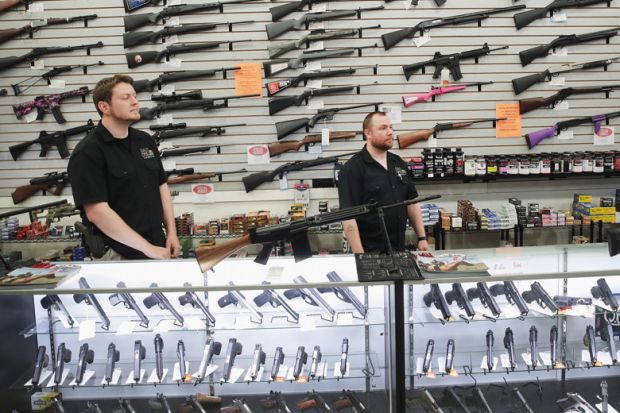It’s a recurring part of the response to gun violence by congressional opponents to restrictions on guns in the US: there hasn’t been enough research by academics and others to know whether such restrictions would actually work.
That’s in large part because the same congressional allies of the powerful National Rifle Association (NRA) have for 20 years choked off the largest source of potential funding for research into gun violence: grants of money from government agencies to study the topic.
Now, in the wake of more mass shootings – including the country’s deadliest by a single gunman, the killing of 49 people at a gay nightclub in Orlando last month – that stranglehold may be loosening.
At least one state, California, is independently making $5 million (£3.78 million) available for gun research at its universities, a few foundations and philanthropies are offering funding for it, federal agencies are slipping money for gun studies into broader grants covering studies of violence in general, and a tiny handful of universities are taking on the contentious issue themselves.
The American Medical Association and other influential groups have also thrown their weight behind government funding for gun research to be restored.
“We could be turning a corner,” said Sherry Hamby, a research professor at the University of the South and editor of the journal Psychology of Violence. “I think Orlando had an impact.”
The ban on federal funding for gun research began in 1996, after a government-funded study by scientists at Emory University and elsewhere concluded that keeping a gun in a home made it more likely that it would be used to kill a family member or acquaintance. The NRA, in response, lobbied Congress to strip the Centers for Disease Control and Prevention of precisely the amount it was spending on studies into guns.
That had the effect of shutting down almost all additional research. So did a congressional order that “none of the funds made available for injury prevention and control at the Centers for Disease Control and Prevention may be used to advocate or promote gun control”.
After the killing in 2012 of 20 children and six adults at an elementary school in Newtown, Connecticut, President Barack Obama used his executive power to direct that the CDC resume studying gun violence. But the Republican-majority Congress controls spending, and Obama’s annual request for $10 million for this purpose has been struck from his budget proposal every year.
To quietly get around this, the CDC and other federal agencies have since 2013 added provisions for gun research to be included in related grants for studies into such things as suicide. Professor Hamby, for example, proposes to make it part of a survey of children’s exposure to violence. Because of the long review process, those projects are just starting to be funded and getting under way.
Given the magnitude of the gun issue, this all still adds up to only a trickle, not only for financial and political reasons, but also because of the potential impact on the careers of academic researchers who consider taking it on.
Thanks to the continuing uncertainty, “you don’t have many new investigators identifying this as an area they want to get into”, said Bill Powderly, director of the Institute for Public Health at Washington University in St Louis, which ran a year-long series of events about the public-health implications of gun violence after a local 16-year-old girl being mentored by the chancellor’s wife was fatally shot.
The initiative shows that conversation about this divisive topic is possible, and that higher education institutions can provide a space for it, he said.
But Washington University remains a rare exception to broader silence in the sector.
Professor Hamby said that researchers were still feeling pressure from above along the lines of “why can’t you keep doing other types of violence research that’s going to draw less attention”. Universities, she said, “because they’re fiscally conservative”, can be risk-averse.
US universities are also dependent for funding and policy decisions on some of the same politicians who are ardently against gun regulation, and fear alienating donors and alumni who may feel strongly about it.
“That’s where everything comes to a screeching halt,” said Patricia Campie, a criminologist and principal researcher at the non-profit, non-partisan American Institutes for Research. “All of these large entities – states, universities, foundations – they all have a range of constituents. They don’t want to put their necks out.”
The result, said Dr Powderly, “is a less-than-coordinated epidemiological effort, and a hodgepodge of data. It hasn’t had the priority from the public-health perspective that 32,000 deaths a year deserve.”
But advocates say that new strategies to study gun violence as a public-health issue or for its connection to terrorism may turn out to be effective.
“Optimism may not be the right word,” Dr Powderly said. “But I’m more hopeful than I would have been two years ago.
“We’re seeing more and more people start to talk about what’s happening in our country as a public health issue, and that is slowly but surely changing the discussion, and framing it in a way that allows people to move beyond the polarisation.”
POSTSCRIPT:
Print headline: Turning point for gun control research?
Register to continue
Why register?
- Registration is free and only takes a moment
- Once registered, you can read 3 articles a month
- Sign up for our newsletter
Subscribe
Or subscribe for unlimited access to:
- Unlimited access to news, views, insights & reviews
- Digital editions
- Digital access to THE’s university and college rankings analysis
Already registered or a current subscriber? Login








